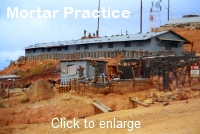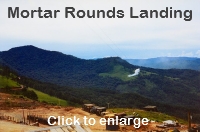
The history behind the green cloth
tab of the Combat Leader began in the European
Theater of Operations in June 1944, when it was
authorized for wear by commanders at all levels from
Squad to Army. Within a few days that authorization
was extended to include other officers and NCO's
whose role in
combat required them to exercise the
function of command even though they might not technically
be assigned as a combat commander (for example, a Second Lieutenant Signal
Corps Officer whose primary duty was signals based
but had been given the additional duty of
commanding a mortar emplacement during enemy attacks).
When the CLI (Combat Leaders
Identification) was adopted Army-wide
in 1948 (IDA Circular 202, dated 7 July 1948), it was
authorized for Infantry, Armored, Airborne and Cavalry
Divisions, Artillery, Constabulary organizations and
certain Signal, Engineer and Chemical Battalions.
Authority was expanded by DA Circular 315, dated 8
October 1945, to Corps level and to personnel of units
whose primary mission was to direct combat training of
Infantry, Armor and Artillery.
In a discussion of the CLI in 1950,
the Army Uniform Board pointed out that it was advisable to remove
symbols of rank
while in close proximity to the enemy and to
substitute the green tabs instead. It was thought that
its design was
inconspicuous yet distinctive enough to serve the
purpose of letting everyone on our side know who was in
charge without waving a red flag over an Officer's head for the
enemy to see.
With that decision green tabs were
effectively adopted as
substitutes for symbols of rank in front line locations, to identify
combat leaders
of each organization.
Yet in spite of the
recommendation to remove symbols of rank, contrary to this advice,
in Vietnam
most junior Officers were so proud of having
earned their tabs that they wore them all the time with
their normal bars pinned on top of them. As far as many of
us were concerned, the hell with Charlie. Being able to
stand out in the crowd back in Camranh as a combat leader
was more important than worrying about a stray bullet or
two. Besides, we were all bullet proof back then anyway, remember?
I
remember the day I got mine. It was the morning after an
attack on our signal site base on top of Lang Bien Mountain,
in the Central Highlands. The site had everything from
microwave to tropo and VHF on it, with three of us Signal
Corps Second Lieutenants assigned from different units in
the 1st Signal Brigade to manage the various communication
equipment housed up there. Up at 7,850 feet above sea level
we felt pretty safe, but as the previous nights probing
attack showed Charlie still liked to let us know he was
around.
 To make sure us Signal boys didn't hurt
ourselves with all of the guns and ammo and stuff that was
laying around the Army
had kindly decided to assign an Infantry Captain as
commander of the overall site, along with his combat
seasoned company. To be accurate about it he and his unit
had been assigned to our Signal Site to handle perimeter
defense as a sort of in-country R&R in thanks for the fact
that they had just come off of 7 months of continuous duty
in the boonies, along the Cambodian border. It seems that
most of the men in the unit were due for rotation back to
the States and it was felt that rather than leave them out
there doing literally daily battle in what was little more
than one long never ending search and destroy mission it
might be better to give them a break and have them pull
guard duty for a bunch of Signal guys on top of Lang Bien
Mountain until they rotated out.
To make sure us Signal boys didn't hurt
ourselves with all of the guns and ammo and stuff that was
laying around the Army
had kindly decided to assign an Infantry Captain as
commander of the overall site, along with his combat
seasoned company. To be accurate about it he and his unit
had been assigned to our Signal Site to handle perimeter
defense as a sort of in-country R&R in thanks for the fact
that they had just come off of 7 months of continuous duty
in the boonies, along the Cambodian border. It seems that
most of the men in the unit were due for rotation back to
the States and it was felt that rather than leave them out
there doing literally daily battle in what was little more
than one long never ending search and destroy mission it
might be better to give them a break and have them pull
guard duty for a bunch of Signal guys on top of Lang Bien
Mountain until they rotated out.
To be honest, it gave me comfort to have
a seasoned Infantry Captain handling combat operations for
our site. Notwithstanding this, when real action came
knocking at our door, usually at about 0330 hours, it was
all men to the ramparts. Everyone pitched in from the most
seasoned Infantry grunt to the most green Signal Corps
private. Everyone had a place and everyone went to it and
I'm proud to say that every single man on that Signal Site
did their job and then some.
 As for us junior Signal Officers, the
Captain assigned us a few additional "combat" related duties
to perform, in addition to whatever it was that our own
units had asked us to do when they sent us up there to Lang
Bien Mountain in the first place. One of the more
interesting
ones
was periodically taking some of the Captain's Infantry
boys out for short search and clear missions along the edge
of our mountain top hangout. More like long walks in the
park than combat patrols, we were to cover various sectors
of the signal site on a random basis and look for signs of
Charlie. The work was usually mundane, but at times Charlie
would get our attention by turning some of the Claymores
around so that they faced back at us rather than out
towards the jungle... and on rare occasions wait in ambush
for us and stage a short fire fight just to let us know he
was still out there.
As for us junior Signal Officers, the
Captain assigned us a few additional "combat" related duties
to perform, in addition to whatever it was that our own
units had asked us to do when they sent us up there to Lang
Bien Mountain in the first place. One of the more
interesting
ones
was periodically taking some of the Captain's Infantry
boys out for short search and clear missions along the edge
of our mountain top hangout. More like long walks in the
park than combat patrols, we were to cover various sectors
of the signal site on a random basis and look for signs of
Charlie. The work was usually mundane, but at times Charlie
would get our attention by turning some of the Claymores
around so that they faced back at us rather than out
towards the jungle... and on rare occasions wait in ambush
for us and stage a short fire fight just to let us know he
was still out there.
During actual attacks on the site one
of the duties the Captain assigned to me was to direct one of the three mortar
emplacements and command the Infantry guys who crewed the
mortar, as well as the troops along the perimeter in my
sector. Located at the only flat spot on the hill from which
Charlie had a chance to breach our perimeter, making sure
that I watched what was happening in my sector, moved my
troops around (... actually they were the Captain's
troops... who all seemed to know where to go and when to get
where they were needed quicker than I could figure out that
they
 were even needed), and keep the Captain (back in the
combat bunker) informed by radio of what was going on kept
me on my toes.
were even needed), and keep the Captain (back in the
combat bunker) informed by radio of what was going on kept
me on my toes.
When
I was first assigned these duties I remember being
apprehensive. Up to that time I had not seen real combat
and wondered how I would make out if we came under attack
and our perimeter was breached. Knowing that I was assigned
to command ground activities for the weakest position on our
site made me nervous. Not knowing if I would be able to
handle myself in my first test of combat worried the hell
out of me.
About 6 weeks after I was assigned these
additional duties it finally happened. Charlie hit us.
At about 0300 everyone on the site was
awakened as the guards in the sector I was responsible for
started firing Claymores, one after another. In what could
not have been more than 10 - 15 seconds they must have
fired at least a dozen Claymores. Up until then I don't
think I had ever heard one... but I can tell you today, the
sound of a dozen Claymores at 3 AM is something you never
forget. That and the staccato of AK-47s answering back.
 Within
a few seconds the site alarm was set and the siren pierced
the night as everyone fell out of bed and headed to their
station. By the time I made it from my bunk to the mortar
pit, a distance of about 30 yards, my guys were already
there... and were firing interdicting fire over the
prearranged pattern we had agreed on weeks earlier.
Within
a few seconds the site alarm was set and the siren pierced
the night as everyone fell out of bed and headed to their
station. By the time I made it from my bunk to the mortar
pit, a distance of about 30 yards, my guys were already
there... and were firing interdicting fire over the
prearranged pattern we had agreed on weeks earlier.
Actually, there I go again... making it
sound like I was in command of the situation. The truth is
that they explained to me on the first day that I took
command of them that they would be more comfortable if
I approved a fire pattern they could initiate on their own
if I failed to get to the mortar pit as fast as they did.
They were kind enough to say that with my other task as a
Signal Officer of overseeing the microwave links back to Nha
Trang, to make sure they stayed up even during an attack, it
was possible that they would be out there in the mortar pit
on their own without my sainted leadership. Having a
pre-approved field of fire, pattern, and sequence of rounds
from HE to Willy Peter and flares to fire would give them
comfort.
Sure enough, just as they predicted, on
that night even though I went straight from my bunk to the
pit they got there first and were already firing their
pattern along the East side of the Signal Site by the time I
had a radio link established with the Captain in his command
center.
All
in all it was a typical probing attack by Charlie. A short,
sharp firefight that ended almost as quickly as it began. An hour or two of fun and it was all over.
The next morning the Captain called me
into his office even before I had a chance to inspect my own
troops for the day. He asked me for an after action report
and when I finished he said to me, "...if you can break from
your Signal duties for the day I would like you to take
your jeep and two of my men and head down into Dalat to
deliver this to the airport for the flight to Danang. Can
you do that?"
Always happy to get a chance to leave
the site and head down into the town I said I would be
happy to. He then said something to the effect of "... oh,
and by the way, you did well last night. Your first time,
right?" I said yes, and he continued, "... your voice broke
a little at the beginning, I could hear it over the radio,
but by the end you were fine. You did well. Here, you earned
these," and he tossed a pair of new green tabs across his
desk at me.
"Put them on when you go down into Dalat
today, and hold your head up as you walk around town
Lieutenant. But listen, don't let them go to your head... if
you get into another dust up today, remember, you probably
have less combat experience than anyone else in this damn
country, so don't start thinking that just because you've
got these on your shoulder you're John Wayne."
I heard him well and I listened to him
too. But I knew he was wrong: I was John Wayne. To be known as a junior
Officer who earned his tabs by fire was something to
feel good about, even if the only people paying attention
to what sat on my shoulder was
the enemy.

